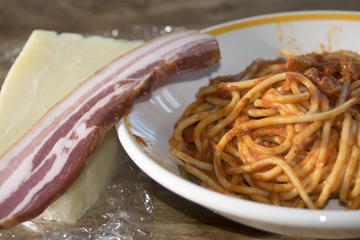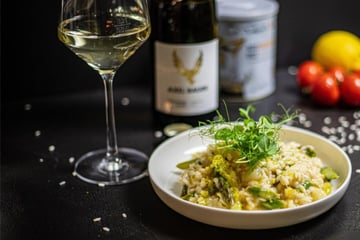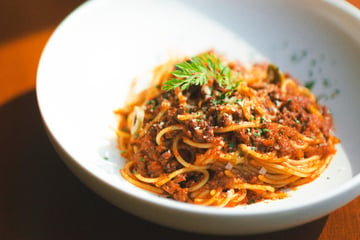How to make Cacio e Pepe: Recipe
When you dive into a bowl of Cacio e Pepe, it might seem like a rather simple combination of pasta, pepper, and cheese. In reality, though, it's pretty difficult to get right. In this recipe, we'll show you how to make Cacio e Pepe.
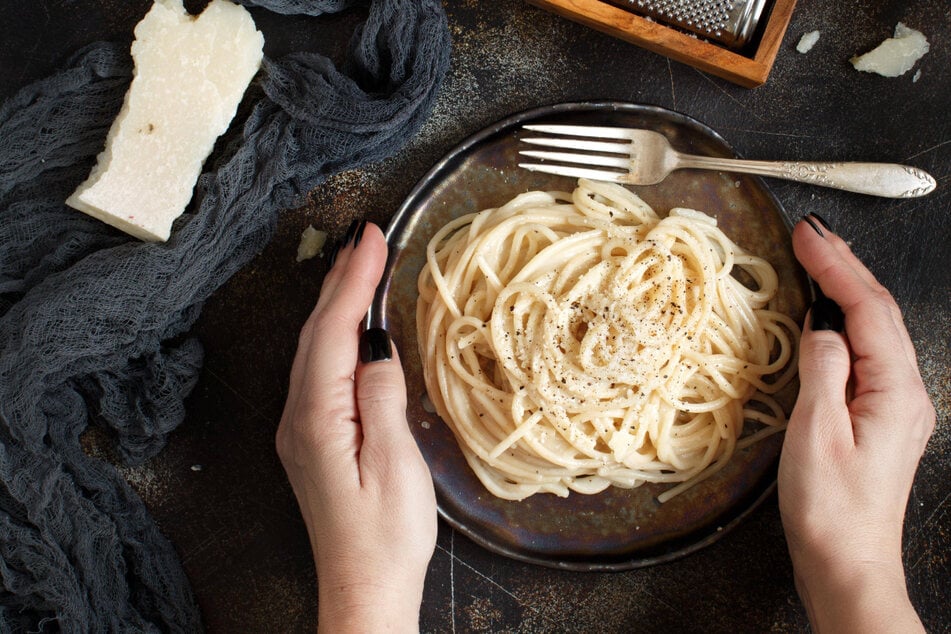
Cacio e Pepe brings that creamy, peppery goodness that you want from any Roman pasta. There's no need for cream, there's no need even for Parmesan, as it's all about the quality of simple ingredients matched with a somewhat difficult technique. Luckily for you, we're here to help.
If you're into good Italian food, this Cacio e Pepe recipe is for you. TAG24 will dive into everything you need to know about Cacio e Pepe. What is it, how do you make it, and what pasta type is best?
What is Cacio e Pepe?
Cacio e Pepe is a pasta dish that originates from Rome in the Italian region of Lazio. It's one of the simplest pasta dishes ever to exist, with its name literally being a description of the two ingredients it requires (other than pasta, of course): Cacio (Pecorino Romano cheese) and pepper.
Generally served with spaghetti or tonnarelli, Cacio e Pepe is all about pairing the simplest of ingredients with the most complicated of techniques. While seemingly simple, it is actually one of the hardest Italian dishes to get right, even if you are a pasta-cooking connoisseur.
Why is Cacio e Pepe so hard to make?
There is one simple reason why people find Cacio e Pepe hard to make: Pecorino cheese has a habit of clumping when mixed incorrectly in water that doesn't contain enough starch or is too hot. Avoiding clumps is rather simple, but requires a technical understanding of what's going on.
When you make Cacio e Pepe, you are basically doing a science experiment. You're creating an emulsion (a joining of two liquids that don't really want to be mixed) between the pasta water and the cheese which will form a cream that's flavored by the pepper.
This emulsion is your sauce, it's the entire dish, and its success comes down to heat. You can get all the components right, you can get the ratios right, but if you don't cook at the right heat, it won't work. Without going into all the scientific specifics, you need to hit a temperature where the cheese will denaturize, but is below boiling.
As a result, you need to painstakingly keep the temperature at 160 °F while making the cheesy sauce. Much higher than this and things will start to clump, as the cheese will not only denature but will coagulate (when a liquid turns into a solid), as well. This is that seemingly secret "trick" to a good Cacio e Pepe...
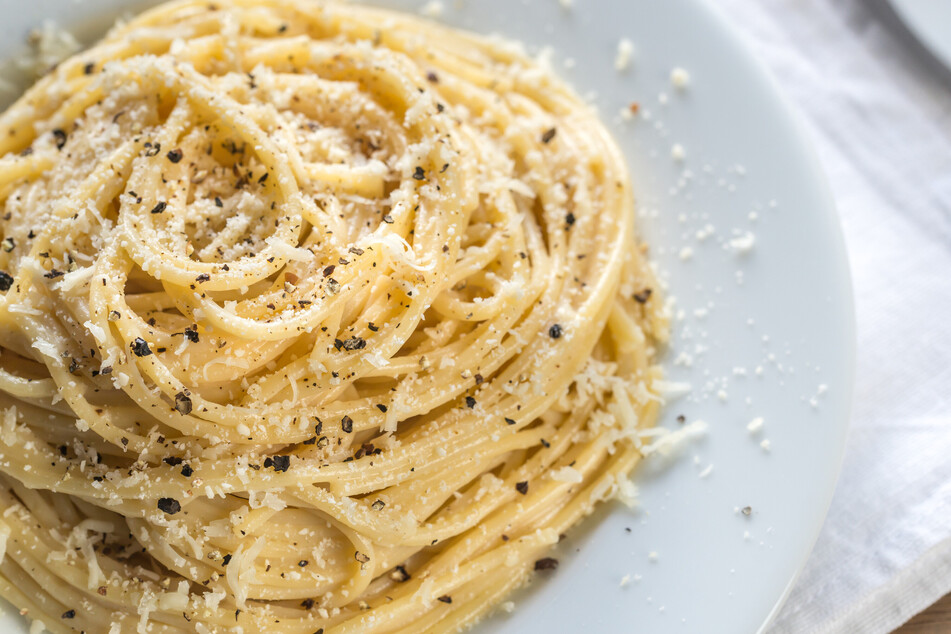
How to make Cacio e Pepe like a Roman
While many people may think it's hard, Cacio e Pepe will be the perfect dinner treat once you have perfected that emulsion. Luckily, the most important thing that you're going to need is the right set of ingredients, as most of us likely own all the equipment required!
Here's what you'll need to make Cacio e Pepe:
- A deep pot for boiling water
- A wide nonstick frying pan
- A wooden spoon
- A scoop
- A cheese grater
You don't need much to make Cacio e Pepe. It's cheap, relatively easy, and quick – you just need to know how. Here's our recipe!
Cacio e Pepe recipe | Ingredients
The ingredients needed for Cacio e Pepe are pretty self-explanatory, but it's important to get the best quality you can, and substitute nothing. There's no need to use Parmesan or Grana Padano, for example. It's incredibly cheap to put together, so get the right stuff and the good stuff.
Here are the ingredients for Cacio e Pepe:
- Pecorino Romano, 5oz (one triangular block)
- Pasta of your choice, 10oz
- Black pepper
- Salt
- Tap water
On the proportions: These ingredients have been chosen to accommodate a meal for two people. If you need to make it for more people, adjust the proportions accordingly, and follow the same instructions.
Cacio e Pepe recipe | Instructions
Here's where we get to the crux of the matter: making Cacio e Pepe! It's easy, but you need to be extra careful with the temperature as we previously discussed. There's no need for a thermometer, but it doesn't hurt if you want to use one.
Here's our easy and cheap-as-chips Cacio e Pepe recipe!
Step 1: Fill up a reasonably sized pot with water until it is about 3/4 full. Since you are cooking about a half pound of pasta, that means that you need about 2 quarts of water.
Step 2: Season your water generously with salt and bring it to a rolling boil on your stove top. Using a lid will speed this process up, but don't leave the lid on when cooking the pasta, or you'll make a mess!
Crushin' that myth: There is no need to season pasta water with oil. If your pasta is sticking, simply give it a stir, and make sure that your water is constantly at a rolling boil while cooking.
Step 3: Once the water is at a rolling boil, add your pasta, and give it a reasonable stir. Cook the pasta until about 1–2 minutes less than the package instructions suggest.
Step 4: While the pasta is boiling, grate all of your cheese and crack a generous amount of pepper into a small bowl. Place your frying pan on the stove until it is ripping hot.
Step 5: About 4 minutes before the pasta is finished boiling, remove about a cup of the starchy pasta water, setting it aside and letting it cool for a little while.
Step 6: About 2 minutes before the pasta is finished boiling, take the frying pan off the heat and put the pepper grinds into it. Toss these pepper grinds and allow them to roast, until fragrant (but not burnt).
Step 7: Once the pasta has finished cooking, remove it from the pot (preserving as much of the water as you can, you might need more than a cup) and add it to the frying pan. Mix it thoroughly, so that the pasta is coated in the pepper.
Step 8: In another bowl, add most of the pecorino cheese (keeping a little bit to garnish with at the end) and slowly mix in the pasta water that you preserved in step five. This should melt down the cheese and form a sort of wet paste.
Warning: If your pasta starts to get clumpy, the water is too hot. Let the water cool a bit more before continuing.
Step 9: Once the mixture is finished, add it to the pasta (with a little bit more of the cooled pasta water) and mix thoroughly, allowing the cheese to melt and form a creamy sauce.
Step 10: If your cream is too loose, or you have lost too much heat, put the pan back on the heat. What you want to do is periodically add and remove heat, not getting too hot, but keeping it nice and warm. At around 160 °F for the duration.
Step 11: That's it! Serve in a nice little bowl and garnish with a dusting of grated Pecorino Romano cheese and cracked black pepper.
Spaghetti, Bucatini, or Tonnarelli Cacio e Pepe: Which pasta?

Pasta is a diverse beast, and different dishes require different shapes. While homemade pasta is fabulous, you don't want to pair it with an emulsion like Cacio e Pepe. Instead, you want a semolina-based dried pasta (what you get from a packet), so that you can cook until it's al dente.
Cacio e Pepe is traditionally paired with spaghetti or, if you want to go proper Roman, tonnarelli. The latter is a delicious, thick noodle pasta that will pick up the sauce incredibly well. You don't have to be super traditional, though! There are a couple of other options, as well.
Here are some great pastas to pair with Cacio e Pepe:
- Spaghetti
- Tonnarelli
- Bucatini
- Tortiglioni
- Conchiglie
- Rigatoni
- Ravioli
- Farfalla
- Fusilli
- Penne
- Gnocchi
Don't be a prude: It's great to make Italian pasta the traditional way (you know, no cream in Carbonara, no spaghetti with Bolognese), but in the end, it's also about taste. If you like a particular type of pasta, go for it!
This might not be the best Cacio e Pepe recipe!
Cacio e Pepe is unbelievably technical, far more than the likes of Carbonara or even homemade gnocchi. Romans have very specific and particular opinions on the matter and will surely find a hole or flaw in this recipe. After all, there's no such things as perfect!
If you have a slightly different technique, but it works, go for it. Just don't commit the cardinal sin: never use cream, and always use the right cheese. You can't have Cacio e Pepe without Cacio, can you?
Cover photo: IMAGO / Panthermedia
